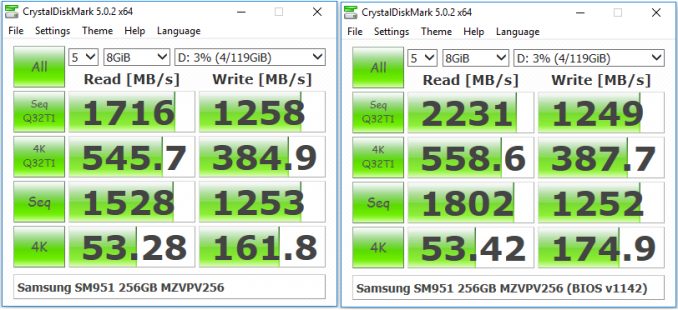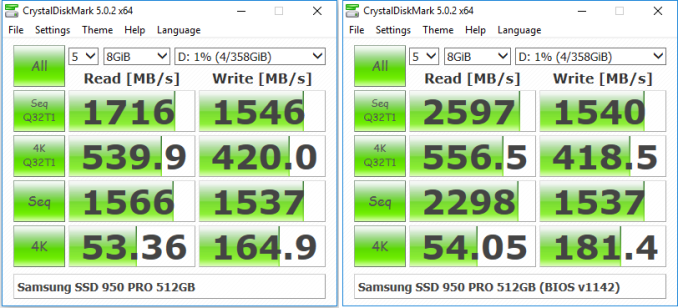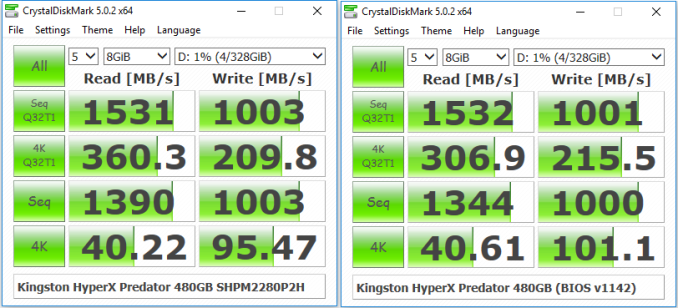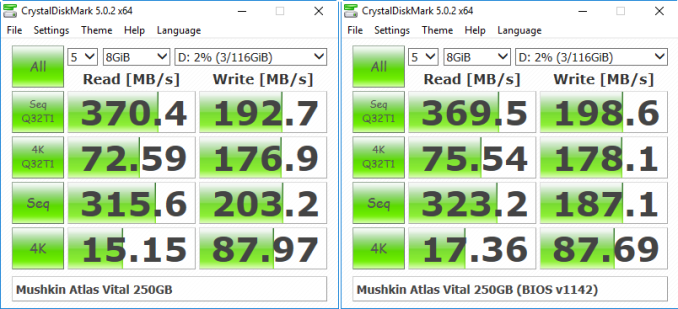Choosing the Right SSD for a Skylake-U System
by Ganesh T S on May 9, 2016 8:00 AM ESTM.2 SSD Options for the Skylake NUC
The M.2 2280 slot in the NUC6i5SYK supports both PCIe and SATA SSDs. The PCIe SSDs (up to Gen3 x4) can be either NVMe or AHCI. A detailed comparison of Non-Volatile Memory Express (NVMe) and the Advanced Host Controller Interface (AHCI) is beyond the scope of this review, but one of our previous articles provides further information. For the purpose of this piece, it is sufficient to know that NVMe SSDs have advantages in performance over AHCI SSDs. SATA SSDs, as seen from the block diagram in the previous section, are connected to the chipset via a SATA III 6Gbps link.
There are plenty of SSDs compatible with the Intel NUC6i5SYK, but, what does one choose for the best experience? There are decisions to make - PCIe 3.0 vs. PCIe 2.0, NVMe vs. AHCI, PCIe vs. SATA and so on. Obviously, a PCIe 3.0 x4 NVMe SSD is the best in terms of performance, but, it might not be great on the wallet, or even for power consumption. In this review, we are going to look at four M.2 SSD options:
- Samsung SM951 256GB PCIe 3.0 x4 NVMe
- Samsung 950 PRO 512GB PCIe 3.0 x4 NVMe
- Kingston HyperX Predator 240GB PCIe 2.0 x4 AHCI
- Mushkin Atlas Vital 250GB SATA 6Gbps
The table below smmarizes the specifications (claimed by the manufacturers) for the various evaluated SSDs. The entries in bold indicate the features corresponding to the tested sample.
| Evaluated M.2 2280 SSDs - Specifications | ||||
| Drive | Samsung SM951 | Samsung SSD 950 PRO | Kingston HyperX Predator | Mushkin Atlas Vital |
| Available Capacities | 128GB, 256GB, 512GB | 256GB, 512GB | 240GB, 480GB | 120GB, 240GB, 250GB, 480GB, 500GB |
| Interface | PCIe 3.0 x4 | PCIe 3.0 x4 | PCIe 2.0 x4 | SATA III |
| Supported Protocols | NVMe, AHCI | NVMe | AHCI | AHCI |
| Evaluated Model | MZVPV256HDGL | MZVKV512 | SHPM2280P2/480G | MKNSSDAV250GB-D8 |
| Controller | Samsung UBX S4LN058A01-8030 |
Marvell Altaplus 88SS9293 |
SandForce SF-2281VB4-SPC | |
| NAND | Samsung 16nm 64Gbit MLC | Samsung V-NAND 32-layer 128Gbit MLC | Toshiba A19nm 64Gbit MLC | MLC |
| DRAM | 512MB | 1GB | - | |
| Sequential Read | 2150MB/s | 2500MB/s | 1400MB/s | 550MB/s |
| Sequential Write | 1260MB/s | 1500MB/s | 1000MB/s | 530MB/s |
| 4KB Random Read | 300K IOPS | 300K IOPS | 117K IOPS | 86K IOPS |
| 4KB Random Write | 100K IOPS | 110K IOPS | 70K IOPS | 86K IOPS |
| Endurance | 75TBW | 400TBW | 892TBW (1.7 DWPD) | N/A |
| Street Price (as on date) | $200 | $318 | $300 | $90 |
| Warranty | OEM / Unknown | Five years | Three years | |
The rest of this section will present more information about each of these SSDs as well as a quick look at their CrystalDiskMark scores, when used in the M.2 slot of the NUC6i5SYK. It must be noted that CrystalDiskMark is an artificial benchmark. Nonetheless, it is useful to determine whether the SSDs are operating as per the manufacturer's claimed specifications. It can also help in finding out whether the SSD is connected via the most optimal interface. For example, it can quickly reveal whether a PCIe x4 SSD is inadvertently being operated in the x1 mode (which is entirely possible due to BIOS settings in certain systems).
Samsung SM951 MZVPV256HDGL 256GB PCIe 3.0 x4 NVMe SSD
The SM951 is an OEM-only M.2 2280 SSD. The 256GB variant is a single-sided card with two flash packages, a single DRAM package and the controller on the top side. In the Skylake NUC, the thermal strip attached to the lid is able to make contact with all the chips on the SSD to aid in cooling down the components.
The gallery below presents some photographs of the sample used in our review.
The screenshots below show the CrystalDiskMark v5.0.2 scores of the SM951 in the Skylake NUC6i5SYK with BIOS v0042 on the left and the new development BIOS (v1142) on the right.
As expected, the change from OPI GT2 to OPI GT4 unlocks the full performance potential of the SM951 PCIe 3.0 x4 NVMe SSD. There is no change in the write speeds, but the maximum read rates go up from 1716 MBps to 2231 MBps.
Samsung SSD 950 PRO MZVKV512 512GB PCIe 3.0 x4 NVMe SSD
The SSD 950 PRO uses the same controller as the SM951. This product is available in the retail channel, unlike the SM951. The main selling point here is the V-NAND, which enables higher endurance ratings (up to 400TB of writes). Like the SM951, despite the higher capacity, the 950 PRO is also single-sided. A label across the top prevents the thermal pad on the NUC lid from coming in direct contact with the packages. As we shall see later, our 950 PRO test sample runs a little bit hotter for the same workload as compared to the SM951.
The gallery below presents a couple of photographs of the sample used in our review.
The screenshots below show the CrystalDiskMark v5.0.2 scores of the SSD 950 PRO in the Skylake NUC6i5SYK with BIOS v0042 on the left and the new development BIOS (v1142) on the right.
As expected, and already seen with the SM951, the change from OPI GT2 to OPI GT4 is required in order to take advantage of the full capabilities of the SSD.
Kingston HyperX Predator SHPM2280P2H/480G 480GB PCIe 2.0 x4 AHCI SSD
Kingston was one of the very few vendors to jump on to the PCIe bandwagon for consumer SSDs. The HyperX Predator PCIe 2.0 x4 SSDs adopt the traditional AHCI protocol, and not the NVMe used by the two Samsung SSDs discussed above. The main selling point of these units is the high endurance ratings compared to the Samsung SSDs. Kingston's three-year warranty period, coupled with a 1.7 drive writes per day (DWPD) rating for the 480GB version comes out to an endurance rating of more than 890TBW.
The SSDs come either in a pure M.2 version, or, bundled along with a half-height / half-length (HHHL) adapter to fit traditional desktop motherboards that don't have a M.2 slot. The HHHL adapter also includes a thermal pad on the underside to keep the components cooled. The 480GB version is populated with eight flash packages (four on either side). The pricing on the various available options (240GB and 480GB, with and without the HHHL adapter) is a bit volatile. I have often seen the HHHL bundle available at a lower price compared to the pure M.2 version.
Kingston sent us the 480GB HHHL version for consideration in this piece. Some photographs of the package and the contents are presented in the gallery below. We again have a label covering the packages and preventing the thermal pad on the NUC lid from doing an effective job of keeping the SSD cool.
The screenshots below show the CrystalDiskMark v5.0.2 scores of the Kingston HyperX Predator M.2 SSD in the Skylake NUC6i5SYK with BIOS v0042 on the left and the new development BIOS (v1142) on the right.
The move from OPI GT2 to OPI GT4 is not expected to make any difference to PCIe 2.0 x4 SSDs, and this is proved by our quick test above.
Mushkin Atlas Vital MKNSSDAV250GB-D8 250GB SATA M.2 SSD
Mushkin has been selling SandForce SF2200-based SSDs for a long time. The DRAM-less nature of the controller means that the the board footprint for the SandForce SSDs tends to be small. Due to this, Mushkin has been able to migrate the designs from 2.5" drives to mSATA and now, down to M.2 form factors. The Atlas Vital is the M.2 version of their SF2200-based drive.
The early review samples of the 250GB Atlas Vital that were seeded to the press used the SF2241 quad-channel controller, but our sample had the eight-channel SF2281 controller. There are only two flash packages on board (making it a single-sided design), though it can be seen that the board is designed to accommodate up to eight packages. Mushkin packages the NAND themselves, and there is no guarantee who the vendor is (except that it is MLC flash). The gallery below shows some photographs of the unit used in our review.
The screenshots below show the CrystalDiskMark v5.0.2 scores of the Mushkin Atlas Vital SSD in the Skylake NUC6i5SYK with BIOS v0042 on the left and the new development BIOS (v1142) on the right.
The SSD is presented here as a value proposition, and is not meant to lead the performance charts obviously. The SATA interface is the main limitation, and the OPI GT2 or GT4 rates have no effect on the performance of the SSD.
Do these artificial benchmark numbers have any bearing on the performance of the drive in real-world workloads that might be run on Skylake-U systems? The next few sections attempt to address that question.





























40 Comments
View All Comments
sorcio46 - Monday, May 9, 2016 - link
Is there a reason why these flash SSDs have a lower 4K read speed compared with 4K write?James5mith - Monday, May 9, 2016 - link
My guess is writes are buffered vs. reads straight from the raw NAND. But I have no idea if it's actually true.hojnikb - Monday, May 9, 2016 - link
More or less this.rossjudson - Thursday, May 12, 2016 - link
Flash drives use variations on log-structured storage. The basic thing going on is that the *logical* block numbers being written (which are random) are not the same as the *physical* blocks being written. Drives create 0-N append points, and all those random writes end up becoming sequential writes to pages. At the high end, your write rate can get limited by the page erase rate, which basically translates to an energy/thermal issue (it takes a fair bit of power to erase flash memory pages). The best high end drives can sustain very high mixed read/write rates -- and the key is "sustain" -- for hours/days. Lots of drives out there can handle a short burst of activity for a few tens of seconds, caching everything in RAM on the hardware until the RAM runs out.Random reads are tougher, because you actually have to go to a random storage block and pull the data. Sequential reads admit lookahead, but random reads don't.
Kristian Vättö - Monday, May 9, 2016 - link
Small writes are cached to DRAM for write combining i.e. multiple IOs are written to NAND at once as the IOs are smaller than the page size. Once the IOs hit the DRAM cache, they are considered complete, hence the higher speed.dzezik - Thursday, May 12, 2016 - link
SF-2281 has no DRAM. this is not a DRAM cache. the old SandForce 2281 was designed for SLC. the performance with MLC is medicorebug77 - Monday, May 9, 2016 - link
And I'm going to make this point again: if even when using NVMe, your random reads are still limited at ~50MB/s, you're only missing on sequential transfers if you stick with AHCI and SATA. Because right now, the bottleneck is elsewhere.Also, for Skylake-U (mobile), SATA offers lower standby power.
Kristian Vättö - Monday, May 9, 2016 - link
50MB/s is a ~50% upgrade over ~30MB/s that SATA offers. It's not even close to what HDD to SSD offers, of course, but we will have to wait for next generation memory for the next huge upgrade.bug77 - Monday, May 9, 2016 - link
SATA can do better than ~30MB/s (not sure whether Skylake-U limits the performance in any way, however).NVMe/PCIe still makes sense, because the price premium is not that large. But I'd like to see more reviews highlighting that if you need to save ~$20, going AHCI/SATA is a better option than getting a smaller drive.
vladx - Monday, May 9, 2016 - link
Price premium is not large? LMAO it's almost double over SATA ones.